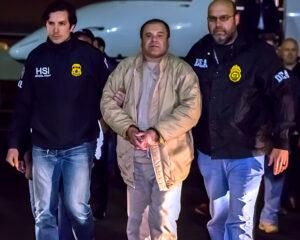Late August and early September drug busts--and Mexican cartel presence--denote worrying signs for CEE
Apart from drones and jets violating Nato/EU airspace, September revealed yet more threats to Central Europe and specifically to Poland by drug traffickers…
And the presence of at least one major Mexican narcotics cartel.
So let’s talk cocaine. I’ve remarked on cocaine trafficking in the past; on Spain, Belgium and Holland as entry points for drugs distributed across the continent and to CEE. Readers will also remember the dire predictions of Yours Truly who pointed out that despite the seemingly endless busts that came in the wake of the Sky ECC encryption breakthrough, the flood of narcotics would slow down, and in fact the threat of gang-backed violence akin to that seen in Holland and Belgium would increase.
This unfortunately appears more and more likely. According to a Europol September press release and Youtube release (Sept. 22, 2025), “Cocaine production in Latin America has reached unprecedented levels while wholesale prices in Europe have dropped and are currently at the lowest level ever.” And again, much of the cocaine trafficked to Europe hits the Spanish or Portugal coastlines first.
Now there is a new twist (and stick with me here, as several events over the past four weeks point to trouble to come): September arrests have seen cocaine trafficked within the skin of cowhides used for leather production—and police and Europol agents believe this has at least for some time managed to defeat detectors and canines both. On this point, multiple arrests have been indicative for a plethora of reasons.
First, on Sept. 3, police completed a “second phase” operation that saw the arrest of citizens from Columbia, the Dominican Republic, Portugal and Spain attempting to use the aforementioned “leather trick.” According to Europol, this resulted in 19 arrests, 32 property searches, 2,232 kilograms of cocaine seized, EUR 150,000 in cash seized and also the seizure of several electronic devices, luxury vehicles, and documentation.
This was followed by a Sept. 10 raid, backed by Spanish Guardia Civil that saw the arrest of a gang smuggling cocaine from South America, with Europe stating that the “suspects, Colombian, Cuban, Romanian and Spanish nationals, were involved in extortion, kidnapping and extreme violence due to its rivalry with other criminal organisations.”
This operation resulted in 37 arrests, 39 property searches, the dismantling of a cocaine cutting laboratory, EUR 600,000 in cash seized, 200 bank accounts frozen, 26 vehicles, 56 real estate and five vessels seized and the seizure of firearms, fake weapons and knives linked to kidnapping and extortion. Among the arrested was a “high value” yet still unnamed target was arrested, who allegedly runs a gang based in both South American and Europe, but who also had his own mini-fishing fleet in Spain.
Yet there is more. In case you are wondering about a Central European link (although, yes, a Romanian was arrested during these raids), note Europol’s concern about violence between competitive groups.
Now note the following: in September Polish police raided a methamphetamine lab near the German border.
Same old thing, right? Just one of many meth raids that The Corners has noted for years.
Nope. This time the lab rats involved were found to not only have been skilled chemists, but to also have been linked to…
The Sinaloa Cartel out of Mexico.
For those somehow unfamiliar with Sinaloa, this is also known as CDS, the Guzman-Loera gang, the Pacific Cartel and the Federation. This is the same cartel formerly headed by Joaquin “El Chapo” Guman, and it has traditionally been unafraid to go to war with all comers, including the Tijuana Cartel, the Gulf Cartel, and later, the Jalisco New Generation Cartel (CJNG) and the Mexican Army.
Despite El Chapo’s arrest, the US DEA still considers this to be the most powerful cartel in the world, and it now not only specializes in cocaine distribution, but also that of meth and fentanyl.

But if that does not scare you, the gang battles in Mexico should, with just the Sinaloa war with the Jaurez Cartel possibly resulting in the deaths of 12,000 people, and the Council on Foreign Relations estimating that 30,000 people a year have died in the Mexican drug wars since 2018.
But back to Sinaloa. Favorite methods of killing often came down to beheadings or dissolving victims in vats of acid. Such acts are remarkably similar to those seen by Serbian and Montenegrin gangs (think the Kavac and Skaljari war), not to mention by gangs exposed during Dutch investigations and the Sky ECC encryption breakthrough.
Which means… if the presence of Sinaloa in Poland doesn’t scare you, well, I don’t know what will.
According to the official Polish Central Bureau of Investigation statement, “Several hundred liters of liquid methamphetamine and semi-finished products, as well as several tons of chemicals used to manufacture methamphetamine, were seized following a CBŚP operation in Świecie County.
“Officers arrested three men, including two Mexican citizens, who, according to findings, supervised the production of the drug and are linked to one of the largest cartels in North America.”
The CBSP noted that the raids were supported by counter-terrorists out of Bydgoszcz, and three men were arrested at the scene, two being Mexican nationals linked to the cartel.
“The foreign nationals supervised the production process and were directly linked to an international drug cartel,” the statement reads.
Yet the Breitbart new organization (specifically Breitbart Texas) noted that these were confirmed Sinaloa members, and that the presence of Mexican overseers represents the latest in a planned gangland strategy to expand further abroad.
Are the busts connected? No, but they are indicative, as the crash in cocaine prices and the rise of renewed distribution together with international gangs picking up on the increasing appetite for meth in Central Europe are all likely omens of drug violence to come.
And more indicative still was a CBSP success that took place at the end of August, with the agency noting that it had nabbed (with the help of… Spanish National Police) two Polish fugitives wanted on European Arrest Warrants for “activities in organized crime groups and numerous drug offenses.”
This is not a minor development, as one of the arrested was 37-year-old Mariusz G., wanted not only on the aforementioned European Arrest Warrant, but also on two arrest warrants issued by the National Prosecutor's Office and the District Court in Kraków, as well on two Interpol Red Diffusions.
Mariusz G. allegedly led an organized criminal group noted for the “brutality of its assaults” and for committing numerous drug-related offenses, with police emphasizing that he was seen as extremely dangerous.
Yet the first detainee, Piotr M., was arrested in early August in Alicante by officers from the Policia Nacional in Levante, following a tip-off from CBSP “shadow hunters.”
Piotr M. was wanted under a European Arrest Warrant and a warrant issued by the District Court in Kraków for narcotics offensives and is now being repatriated to Poland.
But yes…
There is more.
In mid-August CBSP officers broke the back of an international narcotics smuggling gang, allegedly populated in part by hooligans out of Silesian football clubs.
During these raids more than 800 kilograms of narcotics were seized, but the primary players in the gang were Poles based…
In Spain.
 Here they organized large-scale shipments of non-fibrous cannabis to more than a dozen European countries, primarily the Republic of Ireland, the Federal Republic of Germany, Austria, and Scandinavian countries with some shipments (between 40 and 200 kilograms of drugs, typically) hitting Poland.
Here they organized large-scale shipments of non-fibrous cannabis to more than a dozen European countries, primarily the Republic of Ireland, the Federal Republic of Germany, Austria, and Scandinavian countries with some shipments (between 40 and 200 kilograms of drugs, typically) hitting Poland.
Law enforcement agencies from several European Union countries from Spain, Ireland, German, France, the Netherlands, the Czech Republic and Italy cooperated in the investigation, but yes, the Spanish-Polish link was strong.
During the investigation some 600 kilograms of marijuana, 180 kilograms of hashish, 40 kilograms of amphetamine sulfate, as well as seven firearms and several hundred rounds of ammunition were seized, and charges have now been filed against more than 170 individuals to date—and the investigation is still ongoing.
In short, this is ugly stuff. And in spite of European, Spanish and Polish successes this only looks to be ramping up. And if the West’s appetite for meth, cocaine and fentanyl knows no bounds, it’s safe to say that the Pandora’s Box of the violence that comes with it will not stop.
Preston Smith is a licensed investigator based in Gdansk, Poland. He can be reached at query@cddi.pl.
Photo credit: El Chapo in US custody by Immigration and Customs Enforcement/Servicio de Inmigración y Control de Aduanas de los Estados Unidos - Ted Psahos, Public domain, via Wikimedia Commons.
Photo credit: Polish Anti-terrorist (BOA) police raiding a meth lab linked to the Sinaloa cartel (top photo) and a Polish suspect linked to arrests of a Spanish-Polish gang with Silesian hooligan members courtesy of the Polish CBSP.


